Whether you’re a construction company owner, general contractor, or construction project manager, building and leading a successful construction team is never an easy task.
That’s because construction teams are, regardless of their function, size, and makeup, comprising people who can be as, if not more, complex than the construction project they’re working on.
In light of this, here’s how you can build and lead a strong construction team in six steps.
In this article...
Define Clear Team Roles and Responsibilities
A strong team is predicated on clearly defined team roles and responsibilities. To do that, you can use different methods, two of which—WBS and RACI—are presented here.
Let’s assume you’re managing, for instance, a design-build project, where design and construction teams work together as a single unit from project conception to completion.
This implies your core project team would include you as the team manager, architects, engineers, interior designers, site supervisors, and other construction specialists, all depending on the nature, size, and scope of the construction project at hand.
To enable all of them to work effectively, you need to clearly define their roles and responsibilities so they would understand what’s expected of them from the start.
And to do that, you need to have a clear view of all the tasks necessary to complete the construction project.
Those tasks are usually organized and visually presented in a work breakdown structure (WBS) like the one partly shown here.
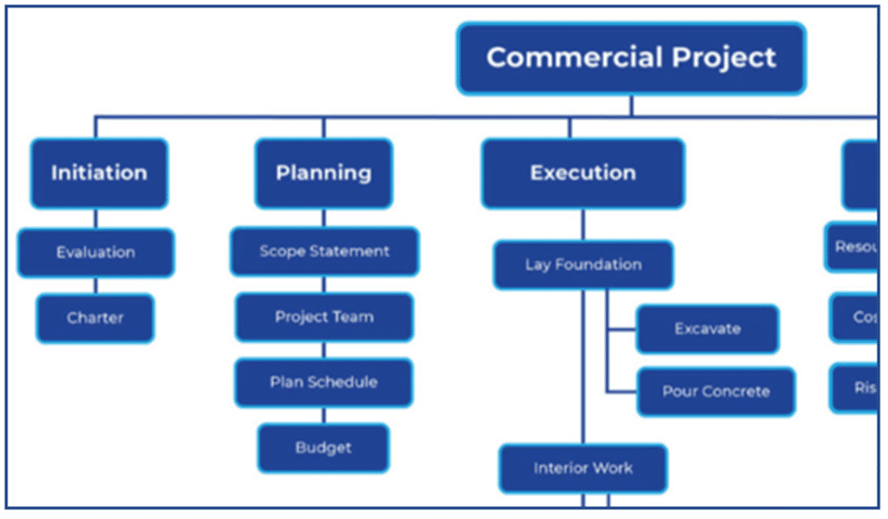
Each stage, such as the project execution (construction proper), is further broken down into more specific tasks, subtasks, and activities.
After they’ve all been defined, prioritized, and sequenced, now you need a method to determine who will be responsible for each task.
An often-used method is a RACI chart, which allows you to determine who’s responsible for doing a specific activity (R), who’s accountable for checking its results (A), who should be consulted (C), and who should be kept informed (I), like in this example.

From this bird’s-eye view with just four stakeholders, it’s clear that the project team or manager is responsible for all pre-construction activities except authorizing expenditure, which is done by the project sponsor (owner, client).
From there on, you can proceed to define more specific team roles and responsibilities.
For example, who in your team will be responsible for performing pre-construction site inspections or building code compliance checks, the last item on the above chart?
When used correctly, the RACI model eliminates role confusion and clearly defines the roles and responsibilities of all team members, both for you and everyone else.
Remember, if you involve your team members in the process of defining their roles and responsibilities, you’re already setting expectations and helping them better understand their roles, thus boosting their confidence and performance from the start.
Find Strong Leaders Within Your Team
The manager might lead a construction project, but successful construction teams have more leaders than one.
Finding people with leadership potential within your team will strengthen team collaboration and cohesion, allowing you to efficiently delegate tasks and empower your team members at the same time.
Although you’ll often hear top executives say that successful team management comes down to picking the best people and getting out of their way, effective leadership actually involves much more than that, namely a lot of trust, communication, coordination, and effective delegation.
In fact, delegation is key because it creates a win-win situation for your team and yourself.
So, how does someone become a great delegator who finds and empowers other strong leaders within their team?
Well, if we combined our article on delegation in construction with some other ones related to the subject, the steps would look something like this:
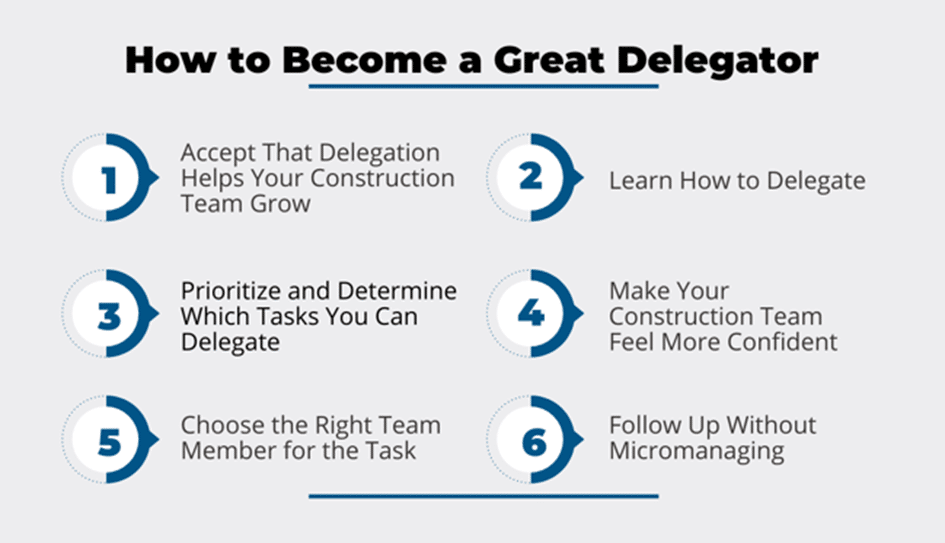
Delegation is even more important in terms of training and developing skilled workers and leaders because, nowadays, almost 90% of construction companies are faced with a lack of skilled labor aggravated by recent health and geopolitical crises.
Some managers may find it hard to delegate, whether they’re afraid to release control due to a lack of trust (nobody could do the job better) or their own insecurities (somebody could do the job better).
A tweet from author Christine Cain best addresses this:

However, before you start delegating, you need to find potential leaders in your team whose skills, experience, and attitude match the task.
To do that, you can look for distinguishing characteristics of informal leaders within your construction team, such as:
- engaged in work, skilled, experienced, and humble
- respected among colleagues, gives deserved praise, avoids taking credit for other people’s work
- fosters trusting relationships with superiors, peers, and subordinates
- provides clear, constructive, and actionable feedback
- takes responsibility for own tasks, has potential solutions ready when asking for help
You can learn more about finding potentially amazing leaders within your team in this Forbes article.
All in all, identifying people with strong leadership potential within your construction team and delegating the right tasks empowers them, sharpens their skills, and boosts their confidence while allowing you to focus on critical project tasks.
Work on Quality Communication
Despite technological advances in construction, human interactions remain at the heart of any construction project. That’s what makes quality team communication essential for successful project completion.
Put simply, when a construction project gets going, you can tell a lot from how the project team communicates.
In theory, you could even predict if the project is going to be prone to delays and budget overruns or not.
If communication is strained and unorganized with poor or no feedback, the project will be more vulnerable to conflicts and mix-ups that can derail its schedule or budget.
Conversely, cohesive and coordinated teamwork coupled with open communication and constructive feedback will help preserve the project schedule, budget, and quality.
As to how to achieve this, here’s a quick look at tips from our article on improving your communication at the construction site:
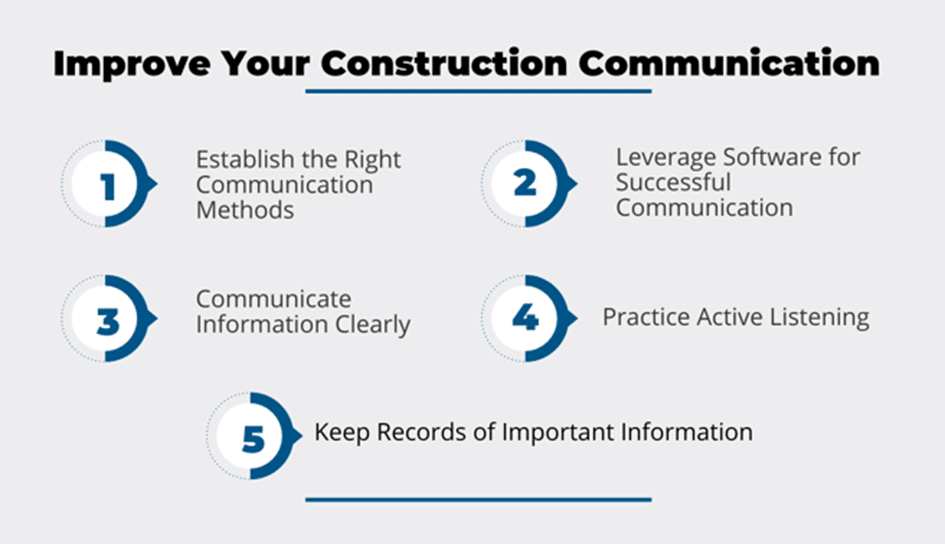
We’ll cover the first two points on that list: team communication methods and software.
On top of setting clear expectations from the start, it’s crucial to establish a clear communication chain of command, so everyone understands who they report to, which gives your team transparent lines of communication and feedback.
Second, you need to choose the right method for keeping everyone informed.
In today’s world, construction team communication software can provide a single source of information and streamline team interactions.
For example, Monday Construction’s schedule template lets you create action items to set expectations and ensure team member accountability.
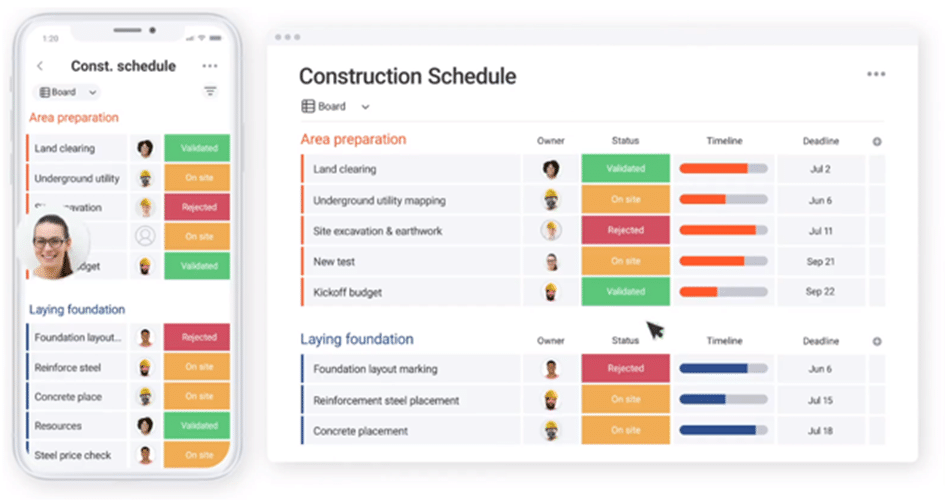
This mobile app allows your team to instantly share files, images, requests-for-information (RFIs), and feedback, thus creating a single team communication platform.
However, they’re effective only if all team members (and other project stakeholders) are committed to using them, along with getting proper training and having adequate access on-site (e.g., internet connection).
Thus, quality team interactions include open communication and constructive feedback.
Establishing the proper communication method and leveraging software are two ways of laying good foundations for quality team communication.
Build Healthy Relationships With Your Team
People are social creatures. So, it’s no surprise that the chemistry of strong construction teams is rooted in good interpersonal relationships.
Thus, fostering a good rapport with your construction team will pay off in many ways, such as higher confidence and motivation of your team members, improved trust and lower stress, all of which lead to increased team productivity.
Getting to know the people in your team over, for instance, face-to-face after-work drinks could be one of the best things for your team dynamics.
Why? Because teams are as strong as they are internally cohesive, and the leader sets the tone in achieving this.
In other words, when team members feel more comfortable with you, they’ll feel more comfortable with one another and more confident to say what they think, give honest feedback, or offer an innovative solution to a problem.

Maintaining good relationships with your team also reduces stress and raises your team members’ work satisfaction and motivation.
In fact, when they are motivated by a feeling of requirement and the recognition of their team value, and positive relationships with their manager and co-workers, it knows no bounds.
Such teams can handle the most demanding construction projects full of, for instance, design errors and unexpected site conditions, which lead to change orders, delays, and cost overruns.
Fostering positive relationships with your team members will give you more insight into the issues they are facing, as well as, conversely, their hidden talents and leadership potential.
Ultimately, building healthy relationships with your workers can relax and improve team dynamics, leading to better individual interactions, open communication, increased trust and innovation, which are the hallmarks of strong construction teams.
Find Ways to Reward Good Work
Yes, financial bonuses are undoubtedly a great way to reward your construction team for good work.
However, there are many other ways to show appreciation that are just as important for improving employee recognition—if not more.
For example, this is how workers in a UK survey responded to what they consider important for a satisfactory professional life:

And feeling trusted, recognized, and appreciated at work is a big part of workplace happiness. Thus, finding ways to show gratitude to your team extends far beyond financial rewards.
Given recent health and geopolitical turmoil, people’s priorities have changed, and emotional intelligence, active listening, and empathy are now managerial skills of the future.
So, rewarding the good work of your team members can take various forms, such as buying your team lunch or giving them an extra hour off on Friday.
And don’t forget that even just saying “Thank you” can go a long way.
However, one of the most rewarding things you can do is show you care about their career development and professional growth, thus showing you’re thinking long-term about their engagement.
Here’s what a reward management strategy used by an Irish mechanical contractor in this case study looks like.

Such strategies or similar actions and gestures will boost their confidence and help strengthen the team.
They will also build their loyalty and lead to higher employee retention, which is crucial for enabling proper training, mentorship, and skills transfer within your construction team or company.
By doing so, you’ll efficiently address the long-standing issue of skilled labor shortages in the construction industry.
All in all, finding tangible and intangible ways to reward your team members for good work will increase their work satisfaction, loyalty, and productivity, making your construction team that much stronger.
Be an Accountable Boss
Being an accountable boss means protecting your team, standing by your word, and being ready to own up to your mistakes. In doing so, you’re showing your team that the accountability you’re asking from them goes both ways.
You most likely had to deal with a fair share of bad bosses in your career.
Those that don’t listen, shift blame and take others’ credit. In fact, maybe you’re dealing with one (or more) right now.
However, leading your construction team gives you an opportunity to change that, at least within your team, while protecting team members from negative outside influences.
This could be the client’s or senior management’s unrealistic expectations concerning some aspect of a construction project or other challenges you encounter daily as the project manager.
Here are the five big ones:
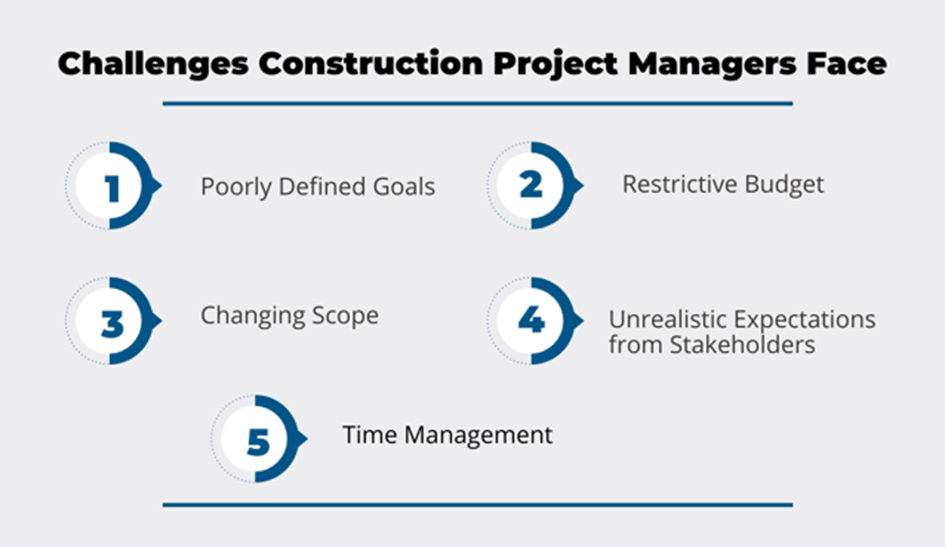
To handle these challenges effectively, you first need to be able to count on your team members and hold them accountable for their actions just as much as you hold yourself for your own.
One of the best methods to establish mutual accountability is to stand by your word of respecting and protecting your team members, provided they do their tasks as expected (and clearly explained).
When you can count on people doing their part, for example, preparing bids for contractors and suppliers, you don’t have to micromanage and can do your job more effectively.
In fact, well-oiled teams work as cohesive units without many management layers.
On the other hand, owning up to your mistakes instead of blame-shifting shows your credibility as a leader.
And great leaders will find ways to protect their team and enhance the construction project.
For instance, you might consider using tools and equipment tracking software to protect your construction crews from injuries or issues with poorly maintained equipment while also optimizing their usage and raising productivity.
An affordable and easy-to-use way to do this is our software solution, GoCodes.

Naturally, these and other construction technologies can streamline all project management tasks, allowing you to be even more accountable as the team leader.
Thus, being an accountable boss requires clear expectations and mutual accountability, allowing you to protect your team and increase their productivity at the same time.
Conclusion
As we said, building and leading a successful construction team is never easy. After all, you’re (still) dealing with humans, not robots.
However, if you take the steps suggested in this article, from defining clear team roles and responsibilities and identifying (other) strong leaders in your team to being an accountable boss, you will considerably improve your chances of creating and managing a strong construction team.



